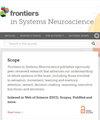下丘脑的神经解剖组织由空间和拓扑效率驱动
IF 3.5
4区 医学
Q2 NEUROSCIENCES
引用次数: 0
摘要
哺乳动物大脑中的下丘脑负责调节与生存和繁殖相关的功能,它由一系列高度相互关联但在解剖学和功能上各不相同的子区域组成。目前仍不清楚是什么因素驱动了下丘脑内亚区域的空间组织。一个潜在的因素可能是网络的结构连通性,这种结构连通性促进了功能的有效发挥,连通性好的子区域在几何上距离更近,即通过最短的几何距离传递最强的轴突信号。为了对这种效率进行实证检验,我们使用了艾伦小鼠脑连接图谱(Allen Mouse Brain Connectivity Atlas)中的下丘脑数据,该图谱提供了由一系列病毒追踪实验得出的小鼠脑区结构连接图。通过成本函数最小化以及与加权球状堆积集合的比较,我们证明下丘脑子区域之间的距离总和并不接近可能的最小距离,这与之前的全脑研究一致。但是,如果用连接性大小的倒数对这些距离进行加权,它们的总和就属于可能的最小值。具体来说,下丘脑出现在随机包装配置的神经效率的前94百分位数内,而当包装被优化以获得最大神经效率时,下丘脑出现在效率中位数的一个标准差内。因此,我们的研究结果表明,几何和拓扑约束的结合有助于控制下丘脑的结构。本文章由计算机程序翻译,如有差异,请以英文原文为准。
The neuroanatomical organization of the hypothalamus is driven by spatial and topological efficiency
The hypothalamus in the mammalian brain is responsible for regulating functions associated with survival and reproduction representing a complex set of highly interconnected, yet anatomically and functionally distinct, sub-regions. It remains unclear what factors drive the spatial organization of sub-regions within the hypothalamus. One potential factor may be structural connectivity of the network that promotes efficient function with well-connected sub-regions placed closer together geometrically, i.e., the strongest axonal signal transferred through the shortest geometrical distance. To empirically test for such efficiency, we use hypothalamic data derived from the Allen Mouse Brain Connectivity Atlas, which provides a structural connectivity map of mouse brain regions derived from a series of viral tracing experiments. Using both cost function minimization and comparison with a weighted, sphere-packing ensemble, we demonstrate that the sum of the distances between hypothalamic sub-regions are not close to the minimum possible distance, consistent with prior whole brain studies. However, if such distances are weighted by the inverse of the magnitude of the connectivity, their sum is among the lowest possible values. Specifically, the hypothalamus appears within the top 94th percentile of neural efficiencies of randomly packed configurations and within one standard deviation of the median efficiency when packings are optimized for maximal neural efficiency. Our results, therefore, indicate that a combination of geometrical and topological constraints help govern the structure of the hypothalamus.
求助全文
通过发布文献求助,成功后即可免费获取论文全文。
去求助
来源期刊

Frontiers in Systems Neuroscience
Neuroscience-Developmental Neuroscience
CiteScore
6.00
自引率
3.30%
发文量
144
审稿时长
14 weeks
期刊介绍:
Frontiers in Systems Neuroscience publishes rigorously peer-reviewed research that advances our understanding of whole systems of the brain, including those involved in sensation, movement, learning and memory, attention, reward, decision-making, reasoning, executive functions, and emotions.
 求助内容:
求助内容: 应助结果提醒方式:
应助结果提醒方式:


